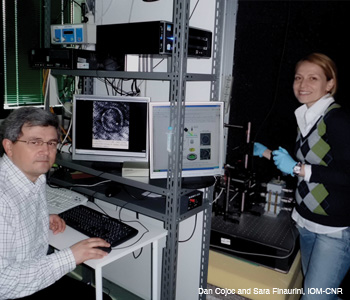Scatterings
Spotting Malaria Fast
An international group of researchers reports that a simple, secondary speckle-sensing microscopy technique quickly and correctly identified malaria in cells
 Dan Cojoc and Sara Finaurini, two of an international group of researchers investigating a technique that offers fast detection of malaria using speckle imaging and automated image analysis methods.
Dan Cojoc and Sara Finaurini, two of an international group of researchers investigating a technique that offers fast detection of malaria using speckle imaging and automated image analysis methods.
An international group of researchers reports that a simple, secondary speckle-sensing microscopy technique quickly and correctly identified malaria in cells (Biomed. Opt. Express 3, 991). The international group (Italy, Israel, Spain and Germany) combined speckle imaging (captured using a laser, simple microscope lens and low-cost image sensor) with two image analysis methods to create a technique with the potential for an automated system that could spot malaria from a drop of blood within 30 minutes.
…Log in or become a member to view the full text of this article.
This article may be available for purchase via the search at Optica Publishing Group.
Optica Members get the full text of Optics & Photonics News, plus a variety of other member benefits.
